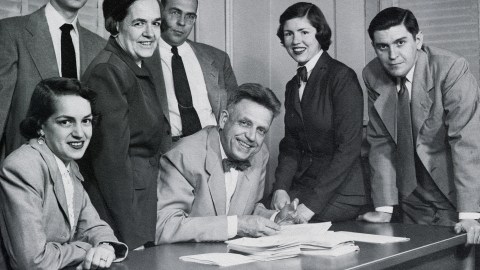Kinsey at 75: How the sexologist enlightened — then scandalized — American society

- Seventy-five years ago, Alfred Kinsey released a book that would transform America. It was the first step in what became known as the Sexual Revolution.
- While his book on men was incredibly popular, his book on women caused a scandal.
- While there were several methodological issues with Kinsey's studies, his work transformed American thinking on sexuality.
Seventy-five years ago, Dr. Alfred Kinsey released a book that transformed American society. When Kinsey published Sexual Behavior In the Human Male, most people didn’t talk about sex. No one knew how much or how little sex everyone else was having. There was no sense of normal, abnormal, common, or rare. Sex was some shadowy taboo locked behind a closed door and a lot of puritanical strictures. Then Kinsey released his study. Suddenly, people could see that their particular sexual predilection wasn’t freakish or pathological — it was a percentage. People weren’t alone; they were part of many. Kinsey shone a light where there was only darkness before.
Kinsey’s 1948 book sold 200,000 copies in two months. His publishers had to keep two printing presses running 24 hours a day to meet demand. All of a sudden, people were using once-whispered words at cocktail parties. They were asking new, exciting questions and looking at their lives in entirely new ways.
But Kinsey’s studies were not without shortcomings; they were based on limited sampling and often distorted perceptions. Here we look at some of the more interesting findings of Kinsey’s work, as well as just how limited a lot of the data might have been.
Celebrating male sexuality
Kinsey was a zoologist. He studied the life and sex of wasps. So, when the students of Indiana University petitioned for a “marriage and family” course (which was, basically, sex education), Kinsey was the obvious choice. In 1940s America, you didn’t study human sexuality. But you could study animal sexuality. If you wanted a course on birds and bees, a wasp expert was the next best thing.
As a zoologist, Kinsey approached his study with the detached, non-judgmental air of a field researcher documenting animals. He would ask questions like, “When did you first masturbate?” or “When did you first have sex with a horse?” (His study found eight percent of U.S. males had engaged in sexual acts with a horse). Phrasing questions in this way presented the topics as normal, and the responses were far more revealing and far more honest than anything that had come before.
Kinsey found that 37% of U.S. men had engaged in a homosexual act to the point of orgasm; 10% had been doing so for at least three years. That 10% figure still dominates our popular understanding of homosexuality rates today (even if the actual rate might be lower than that). Kinsey found that roughly half of all married men had cheated on their spouses. On average, married couples in their 20s had sex 2-3 times per week. This declined as age increased. Kinsey found that 92% of men admitted to masturbation.
Horror at female sexuality
When Kinsey released his research into men’s sexual habits, it was a hot success. It was widely lauded across most academia, and while there was the predictable moral panic from the usual quarters, it permeated mainstream American culture.
When he released the female version of his research in 1953, however, things were a very different story. There were literal book burnings. It scandalized politicians, academics, and the media, vying with the threat of nuclear holocaust for front-page space. It turns out that the American public was fine with knowing about male sexual secrets but horrified by those of females. And what were those secrets? Kinsey told America that half of women had had premarital sex and 25% had cheated on their husbands. Telling male readers that one in four of their wives had cheated on them was quite a bold thing to do. What’s more, Kinsey found that over 60% of women masturbated, and roughly 13% had had a lesbian experience.
Men having sex and indulging in behavior that was, at the time, considered deviant was a bestselling, laughing success. But knowing your daughter, sister, wife, or mother was having sex too? Well, that was appalling.
Sampling bias
No one before Kinsey had attempted to do research into the sexual habits of the American population. And given his comparatively small funding and the fact that he was starting from scratch, the Kinsey reports were incredible. He tried his best to sample as wide a portion of the general population as possible, even going into prisons to ask the incarcerated. His interviews would last between 3 and 18 hours, and his accepting, matter-of-fact manner invited honesty from his participants. That said, Kinsey’s data suffered from an all-too-common problem: sampling bias.
Sampling bias is a problem that occurs when you don’t select participants at random. For instance, if you go to Boston and ask who the best NFL team is, most will say the Patriots. Kinsey relied on “convenience sampling,” meaning he picked the most convenient participants: college students who volunteered for his interviews. Relying so heavily on college students would have skewed Kinsey’s results. College students, particularly those who are keen to talk about it, have different sexual habits than the general population.
In 1953, the Herald-Express wrote, “We do not believe the Kinsey report is a fair report of American womanhood. The types of women who would reveal sex secrets to investigators for Dr. Kinsey are comparatively few.” While the newspaper was certainly caught up in the anti-Kinsey hysteria following his female report, they also have a point: Volunteer bias is a real thing.
What’s more, while including prisoners was laudable, Kinsey’s report included higher-than-average participation rates for the incarcerated. For the 1948 male report, about 18% of the men had spent some time in prison. Having so many prisoners likely would have made deviant or illegal activities appear more widespread than they were. It should be noted, however, that when this data was cleaned by the Kinsey Institute in the 1970s (with prison data removed), the rates of homosexual acts, for instance, barely changed.
Credit where credit is due
Even with those caveats, the Kinsey reports were groundbreaking. Today, we are so used to the internet, where we can find people just like us. We can feel seen and join all sorts of groups for all sorts of things. Back in the 1940s, sex and sexual fantasies were entirely private. People felt trapped, isolated, or scared. With Kinsey, things that might be seen as illegal or aberrant were shown to be happening at high frequencies. It changed how Americans viewed sexuality.





